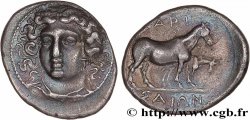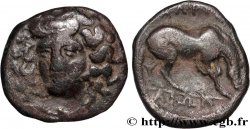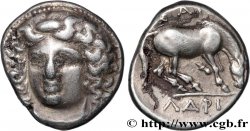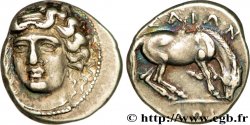bgr_464532 - THESSALY - LARISSA Hemidrachme
Not available.
Item sold on our e-shop (2020)
Price : 250.00 €
Item sold on our e-shop (2020)
Price : 250.00 €
Type : Hemidrachme
Date: c. 350-340 AC.
Mint name / Town : Larissa, Thessalie
Metal : silver
Diameter : 15,5 mm
Orientation dies : 6 h.
Weight : 2,19 g.
Rarity : R1
Coments on the condition:
Exemplaire sur un flan ovale bien centré des deux côtés court sur la légende de revers. Belle tête de Larissa. Joli revers de style fin. Patine grise superficielle
Catalogue references :
Obverse
Obverse legend : ANÉPIGRAPHE.
Obverse description : Tête de la nymphe Larissa de face tournée de trois-quarts de face à gauche, les cheveux retenus par un bandeau (l'ampyx).
Reverse
Reverse description : Cheval paissant à droite, l'antérieur repose sur la ligne de sol.
Reverse legend : [LARIS]//AIWN/ X
Reverse translation : (de Larissa).
Commentary
Poids très léger. Début de cassure de coin perceptible au revers dans la légende. Cet exemplaire, sur un flan relativement étroit tout en étant relativement complet, nous montre la maîtrise artistique du graveur qui a su habilement adapter son sujet à la forme circulaire du flan, tant au niveau du droit, où la chevelure vient harmonieusement occuper l’ensemble du flan et au revers, où le cheval semble se courber. Cette position où le cheval pose l’antérieur sur le sol semble beaucoup plus rare que ceux où il est carrément courbé avec le même antérieur plié.








 Report a mistake
Report a mistake Print the page
Print the page Share my selection
Share my selection Ask a question
Ask a question Consign / sell
Consign / sell
 Full data
Full data











